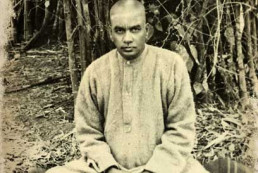Pujya Gurudev revered, adored and worshipped his Guru, Parama Pujya Swami Tapovan Maharaj. “All my life is a story of my love for him,” said he in a moment of quiet reverie. In every yajnasala, the picture of Swami Tapovan Maharaj would adorn the altar on the dais and smile his benign blessings as his disciple quoted and explained, reasoned and cajoled, proclaimed and roared the truth of the scriptures from the vyasa peeth.
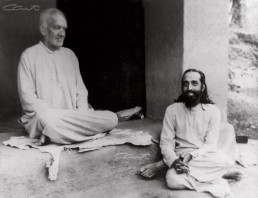
And all the adulation he received was passed on meticulously to his Guru in an act of mental surrender. In fact, he would teach his students, the future acharyas, how to accept the prostrations of the devotees gracefully and pass them on to the Lord or to the Guru, so that there is no chance for the ego to get fattened!
The last few years of Swami Tapovanam's bodily life.
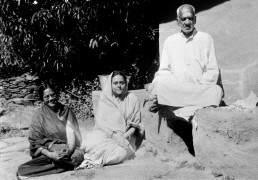
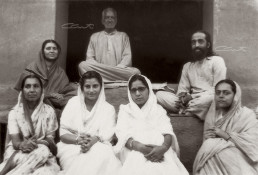
By the end of 1955, Swami Tapovan Maharaj's health began to deteriorate. It was a trying time for Gurudev and he visited Uttarkashi as often as possible in between the jnana yajnas. He kept up a regular correspondence and sent medical help.
In a letter dated September 9, 1955, Pujya Gurudev writes to Shakuntala Bindra:

I must hurry to Gangotri. I had a note from Swamiji Maharaj which read that he is feeling weak and fatigued though not ill. Such a statement cannot easily come from his lips unless he is feeling really bad. I must hurry up to meet him.
Gurudev felt that Swami Tapovan Maharaj needed to be hospitalized, but the Guru who was an embodiment of equanimity refused:

Are there not people dying in London, in New York, and in Delhi with all the best facilities for diagnosis and treatment? Then why should I not end my life in peace amidst the Himalayas where I have lived for so many years?
Chinmaya, you go and continue the work …
On June 22nd 1956 Swami Tapovanam wrote this letter to Gurudev.
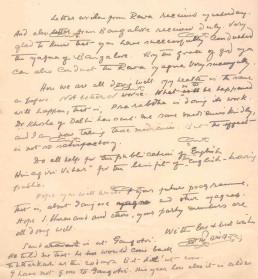
Letter written from Rewa received yesterday. And also letter written from Bangalore received duly. Very glad to know that you have successfully conducted the yagna of Bangalore. By the grace of God you can also conduct the Rewa yagna very successfully.
Here we are all doing well. My health is the same as before. Not better or worse. What is to happen will happen, that is, prarabdha is doing its work. Dr. Khosla of Delhi has sent me some medicines kindly, and I am now taking those medicines. But the effect is not so satisfactory.
Do all help for the publication of English “Himagiri Vihar” for the benefit of the English knowing public.
Hope you will write your future programme, that is, about Tanjore and other yagnas. Hope S. Atmanand and others, your party members are doing well.
Sundaranand is at Gangotri. He told me that he would come back to Uttarkashi within twenty days. But didn’t come. I have not gone to Gangotri. This year here also it is cold now.
With love and best wishes,
Swami Tapovanam
Then came a telegram dated 18th January, 1957, informing him of Swami Tapovan Maharaj's mahasamadhi on the 16th morning.
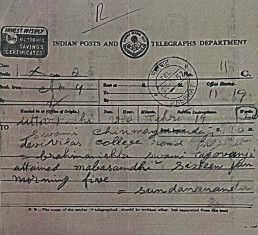
Uttarkashi-via-Tehri
Swami Chinmayanandaji,
Devi Vilas, College Road, Palghat
Brahmanishta Swami Tapovanji attained mahasamadhi sixteenth January morning five.
– Sundarananda
A letter to Sheela Sharma, written by Pujya Gurudev soon after he received the telegram, reflects his distraught state of mind in his handwriting:
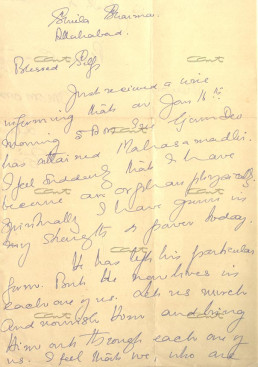

Just received a wire informing that on Jan 16th morning 5 AM Sree Gurudev has attained Mahasamadhi. I feel suddenly that I have become an orphan physically. Spiritually I have grown in my strength and power today.
He has left his particular form. But he now lives in each one of us. Let us nurture and nourish Him and bring Him out through each one of us. I feel that we, who are all His Shishya Parampara must consider 16th of every month as a perfect holiday to be spent in prayers, study, contemplation and live in fast and tapas.

Sri Gurudev has retired from his visible Manifestation to become the intimate inner glow in all true devotees. Before you had to go to Uttarkasi to meet him; now he is within you to be experienced constantly.

Sri Gurudev has retired from his visible Manifestation to become the intimate inner glow in all true devotees. Before you had to go to Uttarkasi to meet him; now he is within you to be experienced constantly.
When Pujya Gurudev received the news, he was conducting a yajna in Palakkad. Travelling from one end of the country to the other was not easy in those days. On February 15, 1957, he wrote:

From Cape Comorin to Uttarkasi was my plan – and reached to schedule up to Rishikesh. Higher up the roads were blocked and so no bus. Thus had to return and at Hardwar did the rituals (shaving off the beard and hair, throwing away shirt etc. for one year) and reached Delhi.
A letter dated April 9, 1957 expresses his anxiety to reach Uttarkashi for the aradhana rituals in the third month and attend to the ashram affairs.

I must reach (this morning train!!) Uttarkasi 14th (Poornima) I must be there for the 3rd Aradhana. I may stay there for another two or three days to recoup, to meditate and to see the organisation of the Ashram. I will be able to reach back Delhi by 23rd or so.
The Disciple became a world-renowned Guru
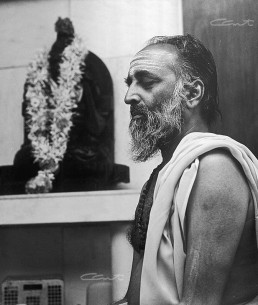
In the years to come, the great disciple would become a world-renowned Guru, but he was careful to point out the correct direction to his disciples and devotees. His magnetic personality drew people to him irresistibly. Who could fail to be overawed by the majestic magnificent figure in flowing orange robes, glowing with a divine aura, speaking fluently in flawless English in a stream of oratory that bathed one into a state of speechless bliss!
Knowing this, he took care that people did not develop an irrational cult of the Guru, worshipping the form, blind to what it symbolized. As early as 1955, he wrote to a devotee called Meenambal:



But I wanted devotees not to mistake the container for the contained: the body for the Self: the Narayan. This mistake, whether it be in ourselves or in our view of our Guru or Ishtam, everywhere this mistake is ignorance.
But as a technique of developing our Atma-Drishti, we can – and most of us must take in the early stages an alambanam (support) for our concentration and steady vichar, a form suggestive of the Divine, the Eternal: maybe a Guru, maybe an Ishtam. Either see the Guru in the Ishtam or the Ishtam in the Guru.
But here the Real Ishtam in the Guru is the Self of the Guru: the sparkle of joy in his eyes, the aura of cheer around him, the scent of purity that he spreads in his life. These have nothing to do with the form, the word, the shape, the dress etc. of the Guru.
If once this is understood and Guru Pooja is undertaken by any devotee of real bhakti and true faith, the Guru can certainly serve as a stronger and more efficient alambanam than even the representations of the Ishtam. After all, the Guru lives, moves, notes, explains; we can hold him by his beard and ask him our doubts and demand an explanation. His language is known to us. Thus this also can be taken up … if properly understood. Do write to me off and on.
Om, Om, Om,
Thy own Self
Chinmayananda
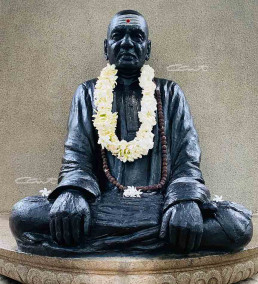
Swami Tapovan Maharaj

Related Links
Swami Tapovanam
Swami Tapovanam
"A God without temples, a Veda without language, a monumental expression of an ideal Vedantic Teacher." Thus did Swami Chinmayananda describe his Guru, Swami Tapovan Maharaj.
From Gurudev's Pen
From Gurudev’s Pen
Swami Chinmayananda brought joy wherever he went. So did his letters. He was a prolific writer, known to write hundreds of letters in a week. The Chinmaya Archives is fortunate to house…
